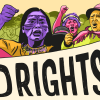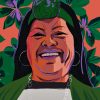Nov. 9, 2016
As world leaders gather in Marrakech, the Global Call to Action on Indigenous and Community Land Rights raises awareness of how secure, legally recognized community tenure rights are key to fighting climate change.
“If land is used properly it contributes to climate change mitigation. The key to using land properly in an environmental and climate change friendly way, is to respect the land rights of indigenous and local communities, and to support them so they are able to use their land in a way that is consistent with them, with sustainable development, and climate change adaptation and mitigation,”
– says Dr. Tony La Viña, Dean of the Ateneo School of Government and a Steering Group member of the Global Call to Action. “If we don’t respect land rights, there is no way forward.”
And all across the world, participants in the Global Call to Action are finding innovative and practical solutions for fighting climate change – at the heart of which are securing land rights and drawing on traditional knowledge.
Indigenous People as “Live Dictionaries”’
After the 2009 typhoon in Taiwan a small group of indigenous peoples decided to work together with local universities and developed a program bringing together Indigenous peoples from the low lands and recent civil engineer graduates focused on adapting to climate change according to the indigenous “natural way”.
The project includes the creation of early disaster warning systems based on the documentation of traditional knowledge from the indigenous peoples living in the high risk areas. “Just before a landslide, you can feel the ground changing, you can smell a distinct rotten smell and you can see the color of the river changing. You can hear the rocks running from the mountains and the different sizes of the rocks tell you what at stage the landslide is,” says Su Hsin from Papora Indigenous Development Association. This knowledge is now used to build early warning systems in many areas.
It also includes the mapping of all high risks mountain areas where, according to Su Hsin, indigenous peoples are “live dictionaries’’ with in-depth knowledge of every aspect of the environment. This is in particularly useful in areas that are hard to reach. This research is used to map the impact of climate change to better comprehend and adapt to the changes of the environment.
“We want to protect everyone from the challenges due to climate change, because it is not just the indigenous peoples that are facing these challenges. Because of our project, people are more interested in us – for us it is about our rights and finally receiving recognition” says Su Hsin.
Reforestation, conservation and carbon storage
In Ghana, the Gbatsive and Salo communities are playing a key role in conserving biodiversity in the Volta region. With support from Green Globe Ghana they are organizing cooperatives to replant the endangered mangroves in Keta Wetlands. Moreover, indigenous communities living in the Kalakpa Forest are protecting the forest by improving forest governance through community level participation and community based Forest Forums. Despite this important work, their tenure rights are insecure.
“Communities living in forest areas are essential to climate change adaptation, but in the Kalakpa forest in Ghana communities don’t have legal landownership” says Samuel Deh from Green Globe Ghana.
Similarly in Laos upland indigenous communities, including the Brao, Ta-oi, Heuny, J’ru, and Souay, are reforesting critical eco zones and developing sustainable forest management systems with support from The Global Association for People and the Environment (GAPE), which works with communities in the Mekong region.
The protection of local natural woodlands and forests in the Chiredzi District of Zimbabwe is being lead by local communities with support from the Southern Alliance for Indigenous Resources (SAFIRE). “This helps 3000 households in rural communities of Malipati to adapt to climate change through promoting the adoption of climate adapted farming methods, like conservation farming, while protecting and enriching their forests and woodlands for carbon storage” says Thubelihle Nyoni.
Another example of conservation can be seen on land managed by pastoralist communities – for example the Naimina Enkiyo forest and the bordering pasturelands in Loita where the Masaai people exercise traditional governance over forestlands and enjoy relative tenure security on land that is uniquely untouched and well preserved.
For this reason, the Mainyoito Pastoralists Integrated Development Organization (MPIDO) in Kenya argues for “more awareness about indigenous peoples’ sustainable resource management systems, which have been critical in the preservation of ecological conservation hotspots. If Indigenous people’s rights are recognized and communities are properly involved, there shall be an improved chance to achieve both environmental mitigation and sustainable livelihoods development for some of the globe’s most vulnerable communities.” This is reiterated by Gideon Sanago from The Pastoralists Indigenous Non Governmental Organizations (PINGO’s) Forum– Tanzania.
“With respect to climate change adaptation, strategies to support indigenous communities should be geared towards building adaptive capacity and resilience through developing policies that provide opportunities to practice mobile livelihoods, enhance and secure access to strategic resources, promote pastoralists’ resilience to droughts by developing livestock markets, defending communal land tenure, good governance and respect for pastoral rights” he says.
These and many other examples will be discussed at a side event, organized by the Government of the Netherlands and the Global Call to Action, on 15 November in the EU Pavilion in Marrakech. Read more here
Photo Credit: © ILC/Jason Taylor
This article was written by Gwendolyn Parami


